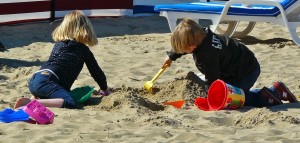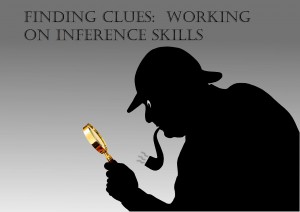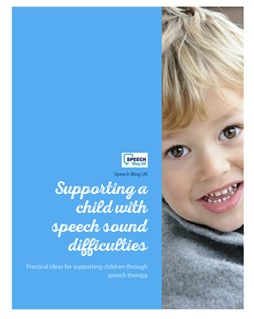Today I’m going to talk about inferencing. This is one of those words that we use a lot as speech therapists and teachers use a fair bit as well, but I don’t think it means a lot to other people! It means understanding things which aren’t directly stated. This is something we all do all the time. For example, if you see someone running as fast as they can towards a station, you don’t need them to tell you that they are trying to catch a train, you just know it. Your brain has put together three pieces of information – running, a station and your previous knowledge that a train goes at a certain time and if you’re not there, you miss it! It seems like a very simple thing, you probably don’t even consciously think about some of the inferences you make, but in fact it is a very complex skill. Children with language difficulties often struggle with this sort of understanding.
Inferencing relates to what is happening now. It is related to but not the same as prediction (the skill of working out what will happen next). Click this link for more information about prediction.
So how can we teach children how to do this? It’s quite difficult and it’s probably not something you can teach in a couple of sessions, but here are some ideas of how to get started.
Many children with language difficulties respond better to pictures than they do to words, so start off with pictures, and real-life situations. With all of these suggestions there will be some examples which are quite easy and others which are much harder. It depends on the number of clues, how obvious they are and the child’s world knowledge as well. You will more than likely find some things are much harder for them than others.
- Talk about real-life situations like the one that I described above and see if the children can find the clues. Explain to them that they need to be detectives and find all the clues. Alternatively you can describe it like a jigsaw, where they need to put all the pieces together.
- Look at photos and pictures in books and see if your child can work out what is happening. Most pictures have inferencing questions you can ask. For example, if we were looking at this picture, I might ask where the children are, or what the
 weather is like. The children may well be able to answer these questions easily, but can they tell you how they know? EG We know that it’s not really hot, as the children are wearing long sleeves. This is also an important skill.
weather is like. The children may well be able to answer these questions easily, but can they tell you how they know? EG We know that it’s not really hot, as the children are wearing long sleeves. This is also an important skill. - Cartoons can be good for inferencing. Take the words away and see if your child can work out what’s happening and explain how they worked it out. If they really struggle with explaining to start with, they may be able to show you the important bits of the picture.
- Try TV clips without the sound. Sometimes you can work out what’s going on, sometimes you can’t. Talk about it together – what clues are there?
- Mime can also be good. Good mime artists add in lots of clues to make their mimes easy to understand – can the children pick out the important bits.
Once your child has had some practise at inferencing with visual information and is beginning to be able to do this, try some verbal information. Here are some ways to try this.
- Start off with short passages but with a lot of clues in them. EG “Sophie put her bucket and spade down on the sand. She took off her flip-flops and walked towards the water” Where was she? Again talk about the clues. Make sure the child is specific about exactly which words are clues, rather than just saying the whole thing again. IE the bucket and spade is the clue, not Sophie or put it down.
- I very often go through the passage with a highlighter pen and we highlight the clue-words. This is a great skill for helping the child to be able to do this independently and make sense of passages of text they come across in class.
- With some children, particularly those who have poor literacy skills, I will read the passage aloud again. I ask the child to say stop or raise a hand when they think they’ve heard a clue. (If I need to, I will sometimes emphasise the clues or pause afterwards to start with to give them extra clues!)
Keep going – these things do take a lot of time! Finally, here are some resources I use to work on inference skills. Some of these work on lots of other things as well, but they include lots of inferencing questions.
How else do you work on inferencing skills? Please add any ideas below this post – I’m always on the look-out for new ideas!







I use a resource called New Reading and Thinking, for school age children. It is published by Learning materials Ltd.